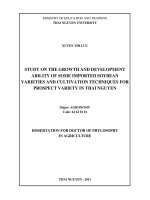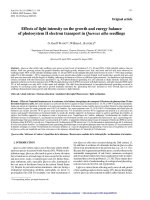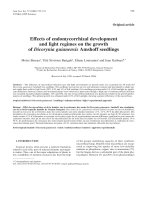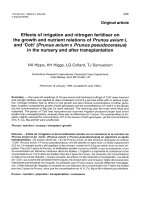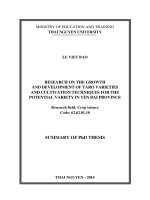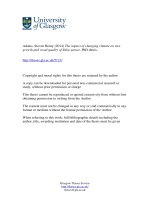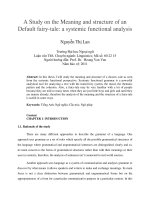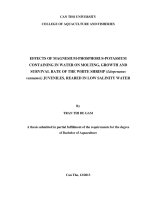Effects of ph on the growth and development of cordyceps militaris at institute forestry research and development, thai nguyen province
Bạn đang xem bản rút gọn của tài liệu. Xem và tải ngay bản đầy đủ của tài liệu tại đây (1.67 MB, 46 trang )
THAI NGUYEN UNIVERSITY
UNIVERSITY OF AGRICULTURE AND FORESTRY
NGUYEN THI LAN ANH
EFFECTS OF pH ON THE GROWTH AND DEVELOPMENT OF
CORDYCEPS MILITARIS AT INSTITUTE FOR FORESTRY RESEARCH
AND DEVELOPMENT, THAI NGUYEN PROVINCE
BACHELOR THESIS
Study Mode: Full - time
Major
: Environmental Science and Management
Faculty
: Advanced Education Program Office
Class
: K46-N01
Batch
: 2014 – 2018
Thai Nguyen, 24/09/2018
DOCUMENTATION PAGE WITH ABSTRACT
Thai Nguyen University Of Agriculture And Forestry
Degree Program:
Bachelor of Environmental Science and Management
Student name:
Nguyen Thi Lan Anh
Student ID:
DTN1454290041
Effects of ph on the growth and development of cordyceps militaris
at institute forestry research and development, Thai Nguyen
province
Nguyen Huu Tho, PhD, Director Office of Research and
International Affairs – Thai Nguyen University of Agriculture and
Forestry, Vietnam.
Thesis Title:
Supervisor’s:
Supervisor’s
signature’s:
Abstract:
In recent years, Codyceps militaris species have become increasingly popular as a health
food supplement. In addition, they are noted by pharmacists for the diversity of biological
compounds. According to traditional Chinese medicine, the Codyceps militaris is used to
successfully treat blood lipid disorders, chronic bronchitis, bronchial asthma, chronic kidney
disease, kidney failure, arrhythmias, hypertension, allergic rhinitis, chronic hepatitis B and
sexual dysfunction. It is also used in treating immune disorders and supporting cancer
treatment.
The biological characteristics of Cordyceps militaris include growth characteristics,
nutrient media, pH of the medium, temperature and humidity. However, this study evaluated
the effect of different pH environments on the growth and development of C. militaris within
50 days. The results showed that when experimenting with 5 different pH treatments(3.5; 4.5;
5.5; 6.5 and 7.5), C.militaris had differnt growth and development in the ability to sprout the
fruit body, the quantity, color, height and diameter of the fruit body. Specifically, with
i
treatment 3 (pH = 5,5) and treatment 4 (pH = 6.5), the mushrooms had a good development
and uniformity. In contrast, C. militaris had a slower development with treatment 5 (pH = 7.5)
and the slowest development with treatment 1 at pH= 3.5. This research has found the optimal
and most suitable pH treatment for the growth and development of C. militaris that was
treatment 3 with pH = 6.5
Key-words:
Cordyceps militaris, fruiting body, experimental treatment, pH,
growth and development.
Number of pages:
Date of submission:
ii
ACKNOWLEDGEMENT
Firstly, I would like to express the deepest appreciation to teachers in
Advanced Education Program Office as well as teachers in Thai Nguyen University of
Agriculture and Forestry, who have dedicated teaching to me the valuable knowledge
during study time in university and gave me a chance to work in this wonderful place.
Formemost, I would like to express my gratitude and deep appreciation for my
supervisor: Dr. Nguyen Huu Tho has enthusiastically instructed me during my
undergraduate thesis writing. I also would like to thank Associate. Prof. Tran Thi Thu
Ha - Director of Forest Research and Development Institute and staffs at agency for
creating the best conditions for me to have the opportunities to practice, study and
write this thesis.
I would like to thank those agencies again and I wish the Institute for Forestry
Research and the Advance education program, Thai Nguyen university of agriculture
and forestry will be achieved more successes in research, education and contribute
more to the social development in the future as well. In the process of implementing
the project, I know that my thesis report got many mistakes so this report is invevitable
shortcomings. So, I would like to receive the attention and feedback from teachers and
friends to this is more complete.
Thai Nguyen, April 2018
Student
Nguyen Thi Lan Anh
iii
TABLE OF CONTENTS
DOCUMENTATION PAGE WITH ABSTRACT ......................................................... i
ACKNOWLEDGEMENT ............................................................................................. iii
TABLE OF CONTENTS ............................................................................................... iv
LIST OF FIGURES AND GRAPHS ............................................................................. vi
LIST OP TABLE .......................................................................................................... vii
LIST OF ABBREVIATIONS ...................................................................................... viii
PART I. INTRODUCTION ............................................................................................ 1
1. 1 Research rationale .................................................................................................... 1
1.2 Research objectives .................................................................................................. 2
1.3 Research question and hypothesis ........................................................................... 2
1.4 Limitations ................................................................................................................ 3
PART II: LITERATURE REVIEW ............................................................................... 4
2.1. The scientific basis of research topic ....................................................................... 4
2.1.1 Definition and distribution of Cordyceps .............................................................. 4
2.1.2 Morphology of Cordyceps ..................................................................................... 5
2.1.3 Some bioactive compounds derived from Cordyceps ........................................... 7
2.1.4 The values of C. militaris for the human health .................................................... 8
2.2. Research situation in the world and in Viet Nam .................................................... 9
2.2.1. In the World ......................................................................................................... 9
2.2.1. In Viet Nam......................................................................................................... 11
PART III. METHOD .................................................................................................... 13
3.1 Materials ................................................................................................................ 13
3.2 Methods.................................................................................................................. 14
3.2.1 Data collection: .................................................................................................... 14
iv
3.2.2 Experimental equipment preparation: .................................................................. 15
3.2.3 Data analysis ........................................................................................................ 16
3.2.4 Conceptual framework ......................................................................................... 17
PART IV: RESULTS AND DISCUSSION ............................................................... 188
4.1. Effect of different pH levels on the ability to grow the fruit body of
C. militaris..................................................................................................................... 18
4.2. Effects of different pH levels on the average number and color of
C. militaris’s fruit bodies .............................................................................................. 19
4.3. Effects of different pH levels on the average height (cm)
of C.militaris’s fruit bodies ........................................................................................... 20
4.4. Effects of different pH levels on the average diameter (mm)
of C.militaris’s fruit bodies ........................................................................................... 22
4.5. The quality of C. militaris’s fruit bodies in the different experimental
treatments of pH. ........................................................................................................... 23
PART V: CONCLUSIONS AND RECOMMENDATIONS ....................................... 25
5.1 Conclusions ............................................................................................................. 25
5.2 Recommendations ................................................................................................... 26
REFERENCES ............................................................................................................. 27
APPENDIX ................................................................................................................... 31
v
LIST OF FIGURES
Figure 2.1. Natural morphology of the mushroom strains: C.sensensis,
C.gunnii, C. barnessi, C. gracilis, C. liangshannesis, C. militaris .................................. 7
Figure 2.2.The major chemical structures are purified from Cordyceps militaris
(A) Cordycepin, (B) Adenosine, (C) Ergrosterol. .......................................................... 8
Figure 3.1. Conceptual framework ............................................................................... 17
Figure 4.1. The different quantity and color of C.mitaris’s fruit boies at
5 different pH levels...................................................................................................... 20
Figure 4.2. Average height (cm) of C. militaris’s fruit bodies in 5 diferent pH levels 21
Figure 4.3 The Difference between average height (cm) and diameter (mm) of
C.militaris’s friut bodies at 5 different pH levels ......................................................... 22
Figure 4.4 Average diameter (mm) of C. militaris’s fruit bodies in 5 diferent pH ..... 22
vi
LIST OF TABLE
Table 2.1. Description of some Cordyceps species’s morphology
(Hui-juan et al. 2011) ...................................................................................................... 6
Table 4.1. Effect of different pH levels on the ability to grow the fruit body
(flask number) of C. militaris ....................................................................................... 18
Table 4.2. Effects of different pH levels on the average number and color
of C. militaris’s fruit bodies .......................................................................................... 19
Table 4.3 Effect of pH level on the height of C.militari’s fruit bodies......................... 20
Table 4.4. Effects of different pH levels on the average diameter (mm)
of C.militaris’s fruit bodies ........................................................................................... 22
Table 4.5 The quality of C. militaris’s fruit bodies in pH = 6.5 ................................... 23
vii
LIST OF ABBREVIATIONS
Ave:
Average
C. militaris:
Cordyceps militaris (mushroom strain)
FIPI:
Forest Inventory and Planning Institute
IFRAD:
Institute for Forestry Research and Development
Lux:
Illumination of light
R:
Repetition
Rpm:
Shaking speed number of cycles/ minute
T:
Treatment
% v/v:
Volume of a mixture is calculated as a percentage of the total volume of
the mixture.
viii
PART I. INTRODUCTION
1. 1 Research rationale
Cordyceps militaris L.ex Fr. is a parasitic fungus in insects, considered to be a
valuable medicinal product, because it contains many active substances (cordycepin,
adenosine, polysaccharides, ergosterol, and mineral substances, etc.), it is good for
human health, suitable for all ages and has the effect of hypoglycemia, antiinflammatory, inhibit the growth of cancer cells, regulate the immune system,
antioxidants, asthma and children rickets and growth retardation (Electronic Press,
2008). With high medicinal value, Cordyceps militaris that being over-harvested due
to extremely scarce and prices are extremely expensive. Currently, the demand for this
type of medicinal herbs is growing, while there are a lot of cordyceps products on the
market with different quality and prices, almost uncontrollable. In Vietnam, there have
not been many publications of the C. militaris cultivation. The supply of this kind of
herbal medicine from reputable, reliable production establishments is almost very few
and the price is significantly high, therefore, it can not meet the needs of consumers,
especially consumers with medium income. Due to biological characteristics and life
cycle of C. militaris, it is very rare in nature. Therefore, finding and using natural C.
militaris as a medicine or functional food is really difficult (Thuy, 2010). As a resuls, it
is important to determine the influence of some external factors on the growth and
development of mycelium formation and fruiting bodies of C. militaris. With the aim
of finding the suitable culture environments for C. militaris growth in Vietnam while
still obtaining mushrooms with full medicinal values to meet the demand for use as
medicine materials, improve human health and replicate the production of C. militaris
1
at lower cost and not too expensive for middle income people to use. Moreover, this is
the basis for the conservation of this precious and rare gene source in the artificial
environment, the research project titled “Effects of pH on the growth and
development of Cordyceps militaris at Institutue for Forestry Research and
Development, Thai Nguyen Province” have been conducted at Thai Nguyen
University of Agriculture and forestry.
1.2 Research objectives
General objective: This study aimed to assess the effect of pH on the growth and
development of Cordyceps militaris D, belongs to subfamily Clavicipitaceae in the
laboratory of the Institutute for Forestry Research and Development (IFRAD), Thai
Nguyen Province.
Details objectives:
- To determine the optimal of pH environment for C. militaris growth and
development.
- To determine the quality of C. militaris’s fruit bodies in the different
experimental treatments of pH.
1.3 Research question and hypothesis
Research question:
- How does the pH impact the growth and development of C. militaris?
- Which pH experimental treatment is the best for culturing C. militaris?
Research hypothesis:
- Ho: Different pH levels do not impact the development of C. militaris.
- H1: Different pH levels impact the development of C. militaris.
2
1.4
Limitations
Because the laboratory lack of equipment, therefore some of the effects of
external environment on the development of C. militaris are difficult to control.
3
PART II: LITERATURE REVIEW
2.1. The scientific basis of research topic
2.1.1 Definition and distribution of Cordyceps
According to John et al. (2005), for thousands of years, Cordyceps has been
regarded as a pioneer in traditional medicine in Vietnam and China. Cordyceps Sacc
Link (4cm to 11 cm) and Cordyceps ophiglossoides Her - Fr (2cm to 6 cm). Cordyceps
is a fungi, it was first discovered by Chinese scientists in the Tibetan Plateau. This
medicinal plant is actually larvae of the Thitarodes or Hepialus species of parasitic
Cordyceps sinensis (Berk) Sacc. The most common Cordyceps are the young worms
of the Hepialus armoricanus. More than 400 Cordyceps subspecies have been found
and described, but only about 36 species are cultured under artificial conditions to
produce fruit bodies (Sun et al., 2006). Among these species, only C. militaris were
grown on a large scale because it has very good medicinal properties and short
production time. In China, 60 species have been found, including C. lilacsensis C., C.
grasspara zang, C. kangdingenis zang, C. guizhouensis Liu, etc. There are also C.
militaris, C. nutans Pat, C. Tricentri Yasuda, C.gunnuii Berk. However, so far, only
two species of Cordyceps sincensis and Cordyceps militaris Link have been studied.
The fungus is widely distributed in China, the Tibetan Plateau, Bhutan, Nepal and
North-East India with the average height from 3500m to 5000m above sea level. Other
studies have also shown that members of Cordyceps can also be found in Thailand,
Korea, Japan, and Vietnam. Cordyceps belongs to:
Kingdom: Fungus
Phylum: Ascomycota
Class: Ascomyceptes
Order: Hypocreales
4
Family: Clavicipataceae
Genus: Cordyceps
Species: C.sinensis (Berk) Sacc
Cordyceps is a fungus found naturally in the form of fruit bodies. The formation
process produces a large fruit body yield in artificial conditions that cannot be
achieved as expected. The cause is that the Cordyceps has a slow growth cycle, the
growth process is often associated with or can be symbiotic with other fungi, hence,
the purity of the wild-type strains then cultured under artificial conditions is rather
difficult.
2.1.2 Morphology of Cordyceps
According to Hui-juan et al. (2011), books in traditional medicine describe the
formation of dermatophytes as follows: Ascomyceptes host fungi are parasitic
caterpillars of a butterfly (Caterpillar) scaly wings, especially in the moth Hepialus
armoricanus, which spawns, hatching eggs and become young worms. In winter, the
larvae crawl into the soil, and in humid environments, Ascomycestes spore on the
insect larvae undergoes appropriate conditions to germinate and grow into the
mycelium. Initially the fungal mycelium was white color, and later on they grew
rapidly into a thick, solid block, some of which turned into dark yellow to brown,
some still developing a faint pink, to orange. Finally, when the nutrients are consumed
completely, the mycelium is rapidly darkened after 30 - 60 days. Then the entire worm
body is just a cover of hyphae. In the summer, from the mouth of the worms, the
mushrooms grow on the surface of the stalk there are sprouts and grow into mushroom
bodies about 10 cm. Below is a table describing the different mushroom forms:
5
Table 2.1. Description of some Cordyceps species’s morphology (Hui-juan et al. 2011)
Species
Larvae
Substrate
The body of the larvae is like a Slender
cylindrical
C. sinensis
silkworm, with a length of 3-5 cm, substrate, 4-7cm in length,
(A)
diameter from 3-8mm, dark yellow 3mm in diameter with
to brown-yellow.
sterile spikes.
The body parts of the larvae are Cylindrical substrate, stout
C. gunnii
(B)
like silkworms, 3-6cm in length, 3- and
rough,
10mm in diameter, yellow-brown length,
to brown.
4-12cm
in
sterile
or
with
branched first peak.
The body of the kidney is short- Single substrate, slender
C. barnesii
(C)
curved, measuring 1.5cm-2 cm in and
curved,
2-6cm
in
length, with a small tip, with a pair length and about 2mm in
of teeth.
diameter
The body of larvae is like a Usually
no
substrate,
silkworm, slender, 2 -4 cm long substrate slivers, 2-3 cm in
C. gracilis
and 2-5 mm in diameter; brown, length and a diameter of
(D)
brown or reddish brown, with 20- about 2 mm, with sterile
40 nodes; legs 8 pairs; sclerotium tip completely.
of hard and solid larvae.
The larval body is like a silkworm, Substrate
like
filament,
C.liangshannesis 3-6cm in length, 6mm-10 mm in branched or non-branched,
(E)
diameter. The outer surface is dark 10-30cm in length and 1brown color.
2mm in diameter.
Flat
C. militaris
(F)
substrate,
Environment nutrients the body no curved,
larvae.
about
slightly
5cm
in
length, orange-yellow to
orange-red
6
Figure 2.1. Natural morphology of the mushroom strains: C.sensensis, C.gunnii,
C. barnessi, C. gracilis, C. liangshannesis, C. militaris
2.1.3 Some bioactive compounds derived from Cordyceps
According to Lo et al (2013), the chemical composition of Cordyceps fungi, the
most important group are cordycepic acid, cordycepin and polysaccharide, are
effective in the treatment of cancer and viral diseases. Besides the three components
on the analysis of fungi, scientists have also discovered many valuable compounds,
such as cordycepic acid, N-acetylgalactosamine, adenosine, ergosterol and ergosterol
esters, bioxanthracenes, hypoxanthine, polysaccharide and exopolysaccharide,
chitinase, cadeapeptins and myriocin, are saccharides (trehalose and polysaccharides),
nucleosides (adenosine, inosine and cordycepin), manitol and sterols (ergosterol) (Lu
et al., 2014).
7
Figure 2.2.The major chemical structures are purified from Cordyceps militaris
(A) Cordycepin, (B) Adenosine, (C) Ergrosterol.
2.1.4 The values of C. militaris for the human health
- Anti-cancer: The ability to inhibit the growth of tumors is found in many
genera of the Cordyceps. Biologically active ingredients with anti-cancer effects are
mainly polysaccharides, sterols and adenosine. In particular, sterols and adenosine are
the hottest research topics in cancer resistance (Zhoua et al. 2009). The anti-cancer
mechanism of C. militaris is:
+ Strengthen the function of the immune system and natural immunity.
+ Selective inhibition of RNA synthesis, thereby affecting protein synthesis.
+ Active antioxidant and anti-free radicals.
+ Anti-mutation.
+ Interference with the replication process of tumor-inducing virus.
+ Induction of methylation of nucleic acid.
- Immune regulation: According to a study by Shashidhara et al. (2013),
Cordyceps' main effects on immune system into cells such as lymphocyte response,
natural killer (NK), and stimulate into: interleukin-2 (IL-2) and tumor necrosis factor
(TNF-α) inhibitors on human mononuclear cells, this is the result of the production of
8
cytokines. The therapeutic effects of mushrooms, such as preventing autoimmune
diseases, allergies and related impacts immunomodulatory.
- Protect other organs: Cordyceps also shows impact on other organ systems.
For example, the nerve center, Cordyceps relieves pain, anticonvulsants and heat
pumps. On the respiratory system, Cordyceps has the effect of dilating the lungs,
namely the increase in adrenaline from the adrenal glands and also the role of
windpipe by histamine. It also has anti-cough effect, eliminate sputum and asthma, and
prevent pneumothorax. In the endocrine system, Cordyceps affects the men's
hormones and increases corticosterone levels (Zhoua et al., 2009).
In recent years Cordyceps has become a very important source of medicine and
functional foods. Most biologically active substances extracted from Cordyceps are
anti-aging agents and effects that help regulate sleep, enhance immunity, and increase
appetite.
2.2. Research situation in the World and in Viet Nam
2.2.1. In the world
In the world, Cordyceps has been studied by scientists and gained a lot of
valuable achievements. With advanced biotechnology, many countries have succeeded
in cultivating Cordyceps substrates and developing the Cordyceps manufacturing
industry. Biofact life (Malaysia) has combined advanced technology from Japan and
other countries successfully cultivated Cordyceps mycelium on artificial environment
to create two main active ingredients Cordycepin and Adenosine are made from
mycelium. Countries such as China, South Korea, the United States, Japan, and
Malaysia have produced industrial capital investments on an industrial scale since
1995, the 20th century (Wang et al., 2010).
9
At the Shanghai Endocrine Research Institute (China), the white spot fungus has
been used to treat impotence effectively. Nan et al. (2001) demonstrated that
Cordyceps was effective in treating hepatic dysfunction. Anti-cancer effects are
mentioned in many studies by authors in many countries around the world. Mushroom
fruit body extracts have anti-cancer effects, which are effective against two types of
umbilical vein membranes, the HT1080 and B16-F10, which are resistant to the
formation of new blood vessels by reducing expression. The present of bFGF, one of
the factors that stimulate this process. Due to its role in suppressing the formation of
blood vessels that inhibit the metastasis and growth of cancer cells (Yoo et al., 2009),
extract from Cordyceps can inhibit the growth of lung, and breast cancer cells (Ahn et
al., 2014). Also, warm water extracts can inhibit the growth of human blood cancer
cell lines by causing cell death through caspase-3 activation (Lee et al., 2006).
The experiment of Kim et al. (2006) showed similar results to the blood cancer
treatment of this fungus extract as well. Scientists have also used extracts from the
fungus for testing on normal cell lines and cancer cell lines. The results showed that
two K562 (leukemia) and Du145 (prostate cancer cell carcinoma) cell lines were
strongly inhibited by solvent extraction with butanol. Anti-aging, anti-inflammatory
effects are shown in research by Won and Park (2005). Ahn et al. (2014) argued that
Cordyceps has anti-inflammatory activity that inhibits the growth of certain viruses,
bacteria, and fungi.
10
2.2.2. In Viet Nam
In Viet Nam, research on Cordyceps is in the new stage to achieve some results.
The new study purposes only thing out, discovered and collected in the conditions of
Vietnam.
In 2009, the Forest Science Institute of Vietnam and the Viet Nam National
Forestry University conducted surveys on Cordyceps nutans in Tay Yen Tu - Son
Dong - Bac Giang. Author Pham Quang Thu has announced the discovery of
Cordyceps nutans. This is the first described and documented mushroom species
distributed in Vietnam (Thu, 2009).
In the Tam Dao National Park, Vinh Phuc, author Pham Quang Thu discovered
Cordyceps Gunnii Cordyceps (Thu, 2009).
In 2009, Pham Thi Thuy collected Cuc Phuong National Park, Ninh Binh
Province, Cordyceps fungus (Newspaper, 2008).
The Cordyceps militaris was first discovered and described in Vietnam (Thu,
2009). These fungi are distributed in natural forests of 1,900m to 2,100m above sea
level. The host of this species is the pupa of the Lepidoptera, a mushroom of 2 to 6.5
cm in length, the shape of the mace, small body and stalk, the head (reproduction) is
enlarged up to 0.6 cm wide. Mushroom’s stalk and reproduction are different colors,
the fungus has smooth orange color, the reproduction is dark orange and many small
bumps. Bottles are plugged in very loosely or are partially plugged into the tissue of
the fungus in the reproduction part. The sporulation bags sized 300 - 510µ x 3,5 – 5µ,
the capsule on the fruit body is 3.5 - 5 μm (Thu & Ha, 2009).
Other areas are also being researched for Cordyceps, usually Cordyceps in
Vietnam distributed in evergreen tropical forests, ranging in height from 800 to 2000
11
m. In the research program of the Vietnam-China Protocol on Cordyceps militaris,
Associate.Prf. Pham Thi Thuy, The plant protection research institute has developed
Cordyceps as a functional food ingredient for humans. As a result, there were three
Cordyceps species:
+ Cordyceps nutans in Cuc Phuong, Ninh Binh and Tam Dao, Vinh Phuc.
+ Cordyceps militaris in Vu Quang, Ha Tinh.
+ Cordyceps sp 1 in Son Dong, Bac Giang.
The author also identified some medicinal properties of C. militaris, including
Cordycepin, HEAA, some vitamins and some trace elements. Above are some initial
results of research on Cordyceps in Vietnam. Therefore, research on this fungus is
necessary to continue to deepen and develop the Cordyceps as a functional food for
humans (Thuy, 2010).
12
PART III. METHOD
3.1 Materials
Research material
3.1.1 Strains: Cordyceps militaris D is a genus from the Vietnamese Genetics
Institute.
3.1.2 Chemicals and raw materials:
+ Peptone, high yeast
+ Triamonicitrate
+ Starch
+ Glucose
+ Acetyl acetone, H2SO2
+ Agar
+ Distilled water.
3.1.3 Research tools:
+ Vials
+ 540 ml bottle
+ Measuring tubes
+ Hoppers
+ Sterile needles (needle diameter Φ = 1.2 mm)
+ Disposable syringes (5 ml)
3.1.4 Research machines:
+ Refrigerator JEIO Tech -SI300 (Made in China)
+ pH meter HANNA (Made in Japan)
13
+ Telstar sterile culture cabinet (Made in Vietnam)
+ SA-300VF Sturdy Sterilizer (Made in Germany)
+ Analytical balance (Made in Switzerland)
+ Refrigerator (Made in Vietnam)
+ Thermo Scientific-Max Q 4000 shaker (Made in Japan)
+ Compact fluorescent lighting system (Made in Vietnam)
3.2 Methods
3.2.1 Data collection:
Before conducting this research, information was accessed from two data
sources include primary data and secondary data:
+ Primary data: Collaborate with staffs of the Institute to collect data.
+ Secondary data is collected from previous studies and reports, available in
newspapers, magazines or scientific websites.
Research is also considered based on two variables: dependent and independent
variables:
+ Dependent variables: the number of fruit boddies inside the experimental
flasks: height, diameter, color of C. militaris’s fruit bodies.
+ Independent variable: different pH levels.
Based on the results of the analysis, the most effective pH experimental treatment
for the growth and development of C. militaris would be determined. Referring
consultants is also an important method for objectively assessing the best application
of the environment for the growth and development of Cordyceps militaris, enabling
subsequent researchers to make informed decisions. It is appropriate to complete the
14
research and propose appropriate consultations with the laboratory to improve the
quality and save time and costs of developing C. militaris.
3.2.2 Experimental equipment preparation: All strains were maintained
according to the procedures provided by the IFRAD laboratory. Silkworms were
bought in households with a tradition of silkworms. The pupae were bought with their
cocoons to ensure they were not contaminated during transport and storage. The
equipment used in this study includes: incubator (JEIO Tech -SI300), biological safety
cabinet (Telstar), pH meter (Hanna), autoclave (SA-300VF Sturdy) air-conditioners,
needle syringes, sterile needles (needle diameter Φ = 1.2 mm), disposable syringes (5
ml), fluorescent lighting systems (capacity per luminaire 0,05W) and samples are
illuminated by fluorescent yellow lamps.
- Implant preparation: Cordyceps militaris D 4% (v / v) spore solution was
prepared and implanted in flasks with a prepared basic environment, followed by
trituration and incubation at 20° C in 7 days. The cylinders containing Cordyceps
militaris spore solutions were inoculated into 540 mL test bottes with 100 mL of a
basic environment (1.5% glucose, 0.5% peptone, 0.3% KH2PO4, 0.1% K2HPO4,
0.05% MgSO4, NaCl 0.05 %) at 25 ° C in a shaker called Thermo Scientific-Max Q
4000 (1.35 rpm) for 3 days. After the test tubes were inoculated with humidity from
80-90%, about 4-5 days after transplant; the fungus will begin to develop the
mycelium and the C. militaris’s fruit bodies will start to grow after 15 days.
- Research design: All experimental treatments were arranged in a completely
randomized design (CRD). There were 5 different experimental treatments of pH
under the homogeneous environment of light, temperature and humidity; each
15
experimental treatment consisted of 20 bottles and was repeated 5 times. Therefore,
the total number of bottle was be 500; the growth and development of fungi were
monitored within 50 days (each stage of fungal growth measured three times, each 15
days apart). Different parameters were selected to evaluate the effect of 5 different pH
treatments on the growth and development of C. militaris.
In order to determine optimum pH for production, C. militaris D was cultured
in a 540 ml flask containing 100 ml of the basic environment with different pH
treatments ranging from 3.5 to 8.5. The pH level of the culture media was adjusted by
using HCl to increase pH or NaOH to reduce pH. The flasks were kept in static mode
in homogeneous environment within 50 days:
T1: pH = 3.5
T2: pH = 4.5
T3: pH = 5.5
T4: pH = 6.5
T5: pH = 7.5
- Tracking indicators:
+ Ability to grow of C. militaris’s fruit bodies (number of flasks)
+ Average number of C. militaris’s fruit bodies
+ The color of the C. militaris’s fruit bodies
+ Average height of C. militaris fruit bodies (cm)
+ Average diameter of C. militaris fruit bodies (mm)
3.2.3 Data analysis
The data was analysed by Excel in Microsoft to calculate the mean of
experiment treatments’ iterations. Moreover, research also use Excel to analyze a
16

